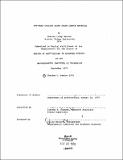| dc.contributor.advisor | Timothy E. Johnson. | en_US |
| dc.contributor.author | Benton, Charles Crisp | en_US |
| dc.contributor.other | Massachusetts Institute of Technology. Dept. of Architecture. | en_US |
| dc.date.accessioned | 2012-07-02T15:16:45Z | |
| dc.date.available | 2012-07-02T15:16:45Z | |
| dc.date.copyright | 1979 | en_US |
| dc.date.issued | 1979 | en_US |
| dc.identifier.uri | http://hdl.handle.net/1721.1/71312 | |
| dc.description | Thesis (M. Arch.)--Massachusetts Institute of Technology, Dept. of Architecture, 1979. | en_US |
| dc.description | MICROFICHE COPY AVAILABLE IN ARCHIVES AND ROTCH. | en_US |
| dc.description | Includes bibliographical references. | en_US |
| dc.description.abstract | The electric utilities in the United States are faced with continued rapid growth in electrical demand. The traditional response to growth in demand has been the expansion of generating capacity. However, economic, environmental, and scheduling constraints will combine to make adequate expansion difficult, if not impossible, in the 1980's. This thesis examines load management as an alternative to the proliferation of generating plants. This path is illustrated by the development of an air conditioning system designed to displace power consumption in commercial buildings from peak to off-peak periods. The urban domestic utilities face their peak loads during the summer air conditioning season. The displacement of daytime air conditioning will therefore reduce the utilities' annual peak load. The proposed air conditioning system uses off-peak power, and conventional mechanical equipment, to recharge a thermal energy storage system. The thermal storage medium is a sodium sulfate-based phase change material (PCM) enclosed in small thin bags. These bags are distributed throughout the ceiling plane of the building; supported by special ceiling tiles. At night, the PCM is charged by chilling the plenum space; during the day, the PCM, in direct contact with the occupied space, removes sensible heat gains by melting. System components are described by their programmatic requirements. The performance of the proposed off-peak cooling system was simulated under a variety of conditions involving interior zone commercial office spaces. It was found, using thermal comfort criteria, that the system performed well using a PCM set point temperature of 67°F. Under the operating parameters established, the simulations indicated that the energy flow rates were adequate for successful system performance. Finally, it was determined that the system can provide immediate savings through customer demand leveling and increased chiller efficiency. However, the major potential for savings will relate to anticipated utility incentives for off-peak electrical use. | en_US |
| dc.description.statementofresponsibility | Charles C. Benton | en_US |
| dc.format.extent | 147 leaves | en_US |
| dc.language.iso | eng | en_US |
| dc.publisher | Massachusetts Institute of Technology | en_US |
| dc.rights | M.I.T. theses are protected by
copyright. They may be viewed from this source for any purpose, but
reproduction or distribution in any format is prohibited without written
permission. See provided URL for inquiries about permission. | en_US |
| dc.rights.uri | http://dspace.mit.edu/handle/1721.1/7582 | en_US |
| dc.subject | Architecture. | en_US |
| dc.subject.lcsh | Air conditioning | en_US |
| dc.subject.lcsh | Heating | en_US |
| dc.subject.lcsh | Ventilation | en_US |
| dc.subject.lcsh | Buildings Energy conservation | en_US |
| dc.title | Off-peak cooling using phase change material | en_US |
| dc.type | Thesis | en_US |
| dc.description.degree | M.Arch. | en_US |
| dc.contributor.department | Massachusetts Institute of Technology. Department of Architecture | |
| dc.identifier.oclc | 06860277 | en_US |
